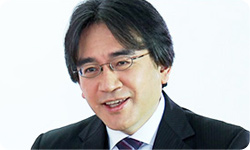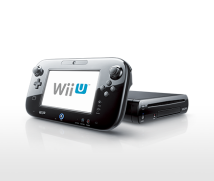3. Good Ideas
Another thing is that by having one more screen it can be used everyday and at anytime. But also, the way it can be utilised is changing the possibility of games. There are probably a lot of different possibilities in the way it can be used.
Yeah.
When I think if a certain idea is good or not, I always think you can tell when that idea is presented, whether it can spur on many new ideas - in this case, in how many ways that it can be utilised. Just like with the Nintendo DS system, when you told us about the idea of making one of the screens a Touch Screen, many ideas flowed from there about new possibilities. This time it's very similar, by it taking on this structure, you're now able to do much more with it. Miyamoto-san, what kind of impressions did you have?
Let's see. I thought that now you'll be able to see the content inside without turning on the big TV, so even if someone is watching something else on the TV set, you're able to play just with this one screen. And in Japan, Karaoke is very popular. It comes with a remote control, and on the larger screen (TV) it displays the information of the song that's currently playing, and the person who's up next is selecting the song on the screen of the remote. I think the same function exists with the new controller.
Right.
Also, many games from Nintendo are a multiplayer experience, where you play in big groups. With the Nintendo 3DS and Nintendo DS systems, you play by not needing to show your screen to anyone else. And with Wii games everyone plays while watching the same screen. With Wii U, you are able to combine both, the ability to display information that no one else can see, and the screen that everyone watches while playing, to come up with new ways to play. In this year's E3, we're demonstrating how that works on the show floor.

So, in a way, the people who are playing are standing on different fields. Not everyone has the same perspective, and the situation becomes more interesting because of that one single player who is looking at the game from a different point of view.
That's exactly right. This is the case with the Nintendo 3DS version of The Legend of Zelda: Ocarina of Time 3D4; there are games that you're able to play much more effectively because it displays both the game screen and the information screen. And, what I noticed as we were making it, was that when I was watching something like a website on a larger screen, I couldn't see it very well with my eyesight! (laughs) 4The Legend of Zelda: Ocarina of Time 3D was released in Japan on June 19, 2011 for the Nintendo 3DS system.
You end up getting closer to the screen anyways because you can't see! (laughs) TVs in recent years usually have a programming guide display on the screen, but with my eyesight even that's pretty hard to see.
Yeah. But still, the TV's large screen size with its wide viewing range is so great. I call this the magnifying glass feature : you're able to see it in any size you like on the screen of the new controller in your hands, so you can easily read what it says while everyone's enjoying the bigger picture on the big screen. With this new controller, you can come up with many new ways to use it, even beyond video games. And since it now has the gyro sensor just like the Nintendo 3DS system5, you can do things like use it with the Wii Zapper . It feels great to play as I'm making games with it, and I feel there are a lot of possibilities. 5Gyro sensor: A measurement device. Its uses include calculating angle, rotation speed, and also controlling position. The term "gyro" refers to a "ring" or "rotation".
By the way, you're the one that forcefully added on the gyro sensor on the Nintendo 3DS system.
I am! (laughs) To make an excuse, we put something back in because now we were able to make the cost work out.
I'm sure you're seeing the benefits of the addition of the gyro sensor already. And in addition to that magnifying glass feature that we just talked about, we also discussed another topic quite a bit. There are times when you read or type with a PC or a smartphone, and when you watch something on a big screen TV while you take a break, or when you want to watch with a group of people so you could share that experience. At first glance, these instances are commonly treated as the same thing, in the way that they are something that is displayed on a screen. But actually these are completely different experiences from one another. Internally we talked a lot about distances whether it's a foot or ten feet, or whether it's thirty centimetres or three meters. In that respect I think this new controller is very interesting in the way that it can accommodate both situations.

Yeah, that's right.
There were things that weren't suited to do in video games... Like when trying to enter text on Wii, even though we placed a lot of effort into it, I do not think we ever reached a point where we could proudly say that it was a stress-free experience. But this time, I feel that will change greatly.
Back when we proposed connectivity in the past by offering two screens between the TV and the Game Boy Advance, we were told that humans aren't able to watch two screens. But in actuality there are many situations where it's better to have a separate information display. I mean, on my desk I have two PC monitors! (laughs) So you can't say people aren't able to watch two screens.
Right, well, it has become very common these days that you will be at home watching TV while you have another device in your hands. I even feel this idea, that you aren't able to watch two screens at once, is a thing of the past.
Yeah. It's more convenient to have things like a software keyboard at your fingertips. Like with a painting tool, it's better to have two screens because the one where you draw, and another to show to someone, are two different functions. With the Nintendo DS system you can draw on it and show it to people but with the household TV, it's too far away to go up to it and draw on it, and then you don't exactly want to show something very small that you drew on your handheld device, you would rather show it on a bigger screen. Even with just this situation, with this new controller, you can draw on the handheld real-time, and you are able to present it to everyone on the big screen . And with photos, they're much more suited to display on a big screen when you want to show it to a lot of people, and it's better to have something in your hands when you select the photos.
There are pictures you don't want to show people. There will probably be times where you don't want to have all the pictures you've taken to be displayed on the big screen at once.
Exactly. You can be ready for those situations if you have two screens. There are a lot of situations like that every day, and features like that are also useful with videos. It has functions that can be useful in daily life.
That's a very similar structure to the Karaoke example we just talked about.
Oh yeah, that's definitely right.
It's very similar with how in Karaoke the information of the song that's playing now is being displayed on the bigger screen, while someone's choosing what to sing next in the palm of his or her hands. Searching and selecting the next picture or video, reading text and then looking for detailed information is easier to do on a handheld device, and sharing that with a group of people is better suited to a big screen. So including that structure, it's critical that this environment is available to everyone from the very beginning.
Right. As Nintendo, it's something we are always conscious of. It's vital to provide the same environment to everyone who purchases our consoles and systems.
